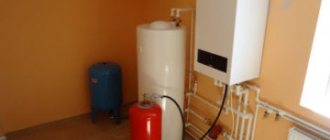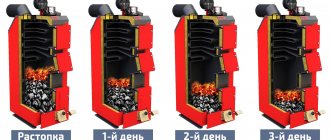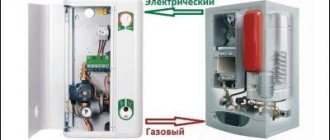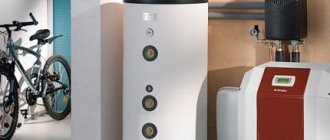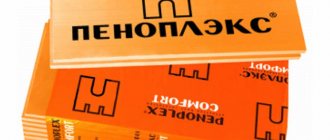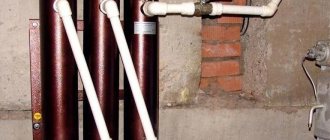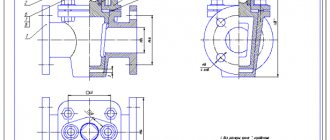The most optimal and economical source of heating for a country house is still a gas boiler.
There are a huge number of manufacturers of these products on our market - Bosch, Buderus, Viessmann, Vaillant, Baxi, Navien, etc.
In addition, there are single-circuit and double-circuit models, traditional and condensation, wall-mounted and floor-mounted, with an open and closed chamber. Which one should you choose and what technical issues should you pay attention to in addition to the brand?
Let us help you understand this matter in order to avoid irreparable mistakes when purchasing.
Power calculation
At present, no one questions the project for power supply to the building. This is taken for granted.
Mistake #1
At the same time, not everyone orders the same heating project.
This leads to problems, first with the correct selection of the power of a gas boiler, and then with its operation.
Mistake #2
You cannot select power based on some average parameters.
The most popular way of them is to divide the total area of the house into 10 m2. As a result, the calculated value is supposedly obtained.
In this case, the thickness and material of the walls, dimensions, number and type of windows, doors, the presence of an attic, etc. are not taken into account.
If you want to find out the average power without a project, at least use online calculators. You should choose those that require you to enter the maximum number of parameters.
For example, this one is TYTS.
But still, for a comfortable and quiet life, initially include in your expenses a separate amount for the heating supply project. It should also include a diagram of the entire heating system and calculate the heat loss of the house.
Design and principle of operation
Double-circuit wall-mounted boilers differ from single-circuit boilers only in the presence of an additional heat exchanger and devices for distributing productivity between the circuits. The technical device may vary from model to model, but the standard design is simple and clear: a burner to which gas is supplied and its igniters → a primary heat exchanger, inside of which there is a heating circuit coolant and a secondary heat exchanger, inside of which sanitary water from the DHW circuit circulates → product removal system combustion into the chimney.
All well-known and common models are already equipped from the factory with all the elements and components necessary for the heating system: expansion tank, circulation pump, automatic air vent, safety valve, pressure gauge, set of sensors, etc. This means that for a standard heating scheme it is enough to just connect the supply and return lines to the boiler, as well as a water source for the DHW circuit (for example, a water supply).
To clearly understand the operating principle of dual-circuit models, let’s consider the functionality of each circuit separately:
- heating - a basic circuit in which the coolant continuously circulates, heating up in the heat exchanger and releasing heat through radiators in heated rooms;
- water heating - activated only when the hot water consumption point is opened, redirects all or a certain part of the heating circuit coolant to water heating.
After closing the consumption tap, the boiler switches back to the heating circuit and heats it up if the coolant has cooled down, or goes into standby mode (background heating) if everything is fine with the temperature.
Traditional double-circuit boilers are always characterized by a delay in the supply of already heated water (from 5 to 15 seconds), but there are models without such a delay, with a built-in boiler, operating on the principle of a storage heater, which we will talk about when describing the selection criteria.
In any case, there is also a delay in the supply of hot water, independent of the boiler, associated with the length of the pipeline between the boiler and the point of consumption, where the cooled water is located.
Electrical and thermal power
When people first see a boiler plate with a power of 24 kW or more, it makes them dumbfounded.
Mistake #3
Wow, how much electricity will such a boiler “reel” in?
Do not confuse the electrical and thermal power of heating devices. In the worst case, a gas boiler consumes no more than 150-200 W per hour from the outlet.
Therefore, to power it during a blackout, conventional batteries with an inverter or so-called UPS are sufficient.
We are not talking about any kilowatts here.
Product installation requirements
The main indicators that determine the possibility of installing a heating device in a particular room are:
- preventing combustion products from accumulating in the room;
- no smoke;
- prevention of emergency situations including fires.
When a gas boiler is operating, the dimensions of the boiler room or other room with equipment are regulated by SNiP. The same standards establish fire safety, which is ensured during installation in compliance with the following rules:
- The distance from floor to ceiling should not be less than 2.5 meters.
- The installed hood carries out three air exchanges.
- It is necessary to have a window with an area allowed by the standards.
- The door must be equipped with a lower grille or replaced with another sample with a gap to the floor of 0.025 m2.
It is not permitted to dismantle a previously installed door and replace it with arches or curtain structures.
Boiler with power reserve
Mistake #4
The greater the power reserve of the boiler, the greater the gas consumption will be.
Therefore, it is not economically profitable to take a gas boiler with a reserve. This is not always true.
First of all, this problem concerns “dumb” floor-standing and obsolete wall-mounted boilers.
This is what the operating schedule for a 20 kW and 30 kW device looks like.
Vertically we have gas consumption, horizontally we have operating time. Two modes, the so-called clocking, are drawn at the top. Bottom – comfortable operation mode with constant power in cold weather.
Easy to install
Which boiler, wall-mounted or floor-mounted, is easier to install? It would seem that this question should concern not potential owners of the unit, but exclusively the craftsmen who will be involved in deploying the heating system. However, do not forget that the buyer, that is, you, will have to pay for this, and the more labor-intensive the work, the more money you will have to part with.
In terms of ease of installation, the wall-mounted boiler is the undisputed leader. In the case of a floor-standing unit, you will have to equip an entire boiler room, because in addition to the boiler itself, you will have to install circulation pumps, an expansion tank and, perhaps, a boiler. The scope of work, as you might guess, differs very significantly, and the cost of the work will vary just as much.
Timing and solution methods
Typically, clocking is observed during the off-season, when there are no severe frosts and there is no need to warm up the system for a long time.
In this situation, the boiler starts at maximum, quickly heats the water and turns off. Next, the pump removes the coolant throughout the system, the temperature drops, and the burners start up again.
In this mode, both 20kW and 30kW boilers operate. What's the difference?
And the difference is that the first one will consume gas during the launch intervals, conditionally 2m3, and the second 3m3. When the boiler cycles, it does not have time to evaluate anything and reach optimal power.
It starts at maximum and stops at maximum. But all this applies to old, “dumb” models.
In modern wall-mounted appliances with modulating burners (1:10) and smart electronics, the boiler’s operation is designed in such a way that if the automation initially detects overheating of the coolant, the next switching on will occur at a lower power, or you can reduce it yourself.
The only problem is when the minimum power of the boiler is not so minimal.
Therefore, check the instructions and ask the seller whether the gas boiler has a modulation function or not. And the more frequent the adjustment step, the better.
Mistake #5
But there is no need to overdo it with the so-called “brains”.
90% of consumers never use weather-dependent automation or GSM modules in their lives. It's not worth overpaying for them.
It’s better to install a couple of smart and inexpensive room thermostats.
More details
Most people solve the age-old problem with clocking in this way.
Kinds
Wall-mounted single-circuit boilers are produced in various design options, which can be divided according to the following characteristics:
By type and material of heat exchanger:
- steel _ Stainless steel is used, which has average capabilities and efficiency. Such units are usually installed on units in the middle and low price range.
- copper _ This unit demonstrates increased heat transfer, durability and efficiency. Installed on expensive models from the most famous manufacturers.
On single-circuit boilers, as a rule, one structural type of heat exchanger is used - tubular. It is a spiral of steel or copper tube, which is heated by a burner flame.
The coolant passing inside manages to get a high temperature and exits to the next nodes completely ready for further work.
By type of burners and combustion chambers:
- atmospheric _ These are open type burners that use air directly from the room. To remove flue gases, they need to be connected to a traditional type chimney with natural draft;
- turbocharged _ These units are closed, so a turbofan provides fresh air and smoke displacement. Their combustion process is more stable, and there are never problems with smoke removal. The only problem may be a fan failure or a power outage.
According to the method of energy transfer:
- convection _ These are boilers that operate on the usual principle of heating the coolant using a burner.
- condensation _ A relatively new design, which uses a two-stage method of heating the coolant. First, it is heated from the heat obtained from the condensation of flue gases, and only after that it enters the heat exchanger, where it finally receives the set temperature. This technique allows you to significantly reduce gas consumption, since the coolant is already heated and does not require too intensive preparation . However, for the operation of condensing boilers, specific conditions are required - the condensation temperature must exceed the return flow temperature. This is only possible on underfloor heating systems, or when the temperature difference between inside and outside is no more than 20°. This is impossible in Russia.
NOTE!
When purchasing a condensing boiler, you should not trust the declared efficiency, which is 107-109%. This is a common marketing ploy. We must first understand how this unit works.
Water volume and gas consumption
Mistake #6
The greater the volume of water in the heating system, the greater the power of the gas boiler should be.
This is not true at all. The final power is affected solely by the heat loss of the building.
The volume of water affects only the speed of INITIAL warming up.
When the temperature reaches the set values, the amount of heat released from the boiler will be the same. It doesn’t matter how much water there will be in the system - 10 liters or 100 liters.
How much gas is needed for heating?
Experts in the field of heating equipment calculate the gas consumption for a specific room and recommend a suitable gas boiler. The size of the unit, of course, affects the power, but does not always affect the amount of gas processed. According to the existing formula, the required parameter is determined as:
V = Q / (Hi x ƞ), where
Q—calculated thermal power, kW/h;
Hi—heat of combustion, kW;
Ƞ—efficiency factor.
Thus, if:
- the average boiler power, usually taken as power divided in half, is 5 kW per hour;
- the specific heat of combustion per 1 m2 is determined to be 0.1 kW (for example, for a house with an area of 100 square meters it will be equal to 10 kW);
- The efficiency, according to the equipment passport, is 95%,
then V = 5 / (10 x 0.95) = 0.53 m3/h.
If we calculate that the heating season is 200 days, and more specifically, 4800 hours, then the amount of gas will be calculated as follows:
0.53 x 4800 = 2544 m3.
Manufacturer country
Which wall-mounted gas boiler is better - Korean or European? It is between them that the struggle most often occurs in this segment.
Mistake #7
Korean boilers are more economical than European ones.
Mistake #8
European boilers are more economical than Korean ones.
All wall-mounted turbocharged boilers work approximately the same. Yes, their filling is different, but this does not affect the SAVINGS.
The efficiency of both Korean and European models is the same. Here you need to look at another parameter, namely, the availability in your city of a service for maintenance and repair of a specific brand.
Because sooner or later your boiler, no matter how reliable it is, WILL BREAK.
Based on this factor, it is worth making a choice in one direction or another. Remember a simple rule - the further you live from the service, the simpler the units you choose.
Prices: summary table
Comparative rating of wall-mounted single-circuit gas boilers:
| Boiler name | Efficiency, % | power, kWt | Gas consumption, m3/h | price, rub. |
| BAXI ECO Four 1.24 | 91,2 | 24 | 2,7–2,0 | 37 000 |
| Protherm Panther 25 KTO | 92,8 | 25 | 2,8–2,1 | 57 000 |
| Vaillant TEC VU 242 5-5 | 91,9 | 24 | 2,9–2,2 | 75 500 |
| Viessmann Vitopend 100 W | 93,0 | 30 | 3,4–2,5 | 56 000 |
| Buderus Logamax U072-18 | 92,1 | 18 | 2,0–2,8 | 40 000 |
| Rinnai BR-UE30 | 92,8 | 29 | 2,7–2,5 | 61 500 |
How to check the manufacturer?
Mistake #9
Often, instead of a gas boiler with European components, you can easily buy a Chinese boiler.
In fact, there is nothing wrong with this, it’s just that sellers should be honest with you from the beginning, and not push purely European quality.
How can you avoid falling for this and check everything yourself? Elementary.
Type the full name of the model into Google and add two words – “CERTIFICATE OF CONFORMITY”. Download it and study it carefully.
Mistake #10
If you cannot find such a certificate at all, then it is better to immediately avoid this model.
Each product that is imported into the territory of the CIS countries must have a certificate. The “Manufacturer” column indicates exactly where the boiler was actually manufactured. Here are two certificates for a visual comparison.
See the “Products” column for the specific brand.
This applies not only to assembly, but also to components. Already, few manufacturers save only on labor at the expense of the Chinese.
Therefore, you should not believe the sellers that the boiler was only assembled with a screwdriver in China, and all its internals are European. Although, again, we repeat, in the modern world, Chinese components are not always bad.
Here, first of all, we are talking about the honesty of the seller.
How to choose a fuel type? Is gas, electricity, solid or liquid fuel better?
House with an area of 200 sq.m. has no significant limitations on area, which gives owners greater freedom in choosing a boiler based on the type of fuel used. In such a cottage, you can equip a separate boiler room and find a place for a floor-standing boiler and a fuel supply for it, or give preference to compact wall-mounted gas or electric models.
- Gas.
It is a very common type of fuel due to its low heating costs compared to other options. Gasification has already been carried out in most regions of Russia, so a gas boiler for a 200 m2 house can be installed there without problems. Even if there is no main gas, many boilers can be converted to use liquefied gas. Gas boilers are produced by all well-known manufacturers (Vaillant, Protherm, Bosch, Baxi and others). Among the most popular series are the Bear, Panther, turboTEC, Luna-3, etc. boilers. When purchasing a gas boiler, you can count on an average efficiency of about 89-92%. Finding specialists in the installation and repair of gas boilers is not a problem, since this type of heating equipment is well known to specialists. - Electricity.
An environmentally friendly, but expensive type of fuel for boilers for a house of 200 sq.m. Due to high heating costs, few owners prefer this option, but the convenience of electric boilers cannot be denied. They are lightweight, ultra-compact, silent, equipped with advanced automation, easy to install and operate. Another big plus is high efficiency (up to 99.5%). Boilers from the Vaillant eloBLOCK or Protherm Skat series are popular. - Solid fuel.
Solid fuel boilers for a house with an area of 200 square meters are effective, but not very common. This group accounts for no more than 15% of all heating boilers installed in Russian houses and cottages. The reasons are simple: not everyone is comfortable storing a supply of firewood, coal or pellets. In addition, solid fuel boilers emit quite a lot of combustion products into the atmosphere and require frequent maintenance (cleaning from soot). However, this type of heating is indispensable in areas without gasification. Efficiency rates are usually in the range of 80-90%. - Liquid fuel (fuel oil, kerosene, diesel).
They are not often used due to the need to allocate a room for a boiler room and a sufficiently large container for storing fuel. Suitable for non-gasified residential areas. They show efficiency comparable to gas boilers.
Double-circuit or single-circuit?
Mistake #11
If in addition to radiators at home there is also a heated floor, then you must definitely buy a double-circuit boiler.
Double-circuit boilers are needed only for hot water supply (DHW) - heating + separate hot water. The single-circuit device copes well with both heated floors and radiators.
All it does is simply heat the water. What kind of heating system you have doesn’t really bother him.
The main thing is to design and calculate everything correctly. In general, for normal hot water supply it is not recommended to buy a boiler with a power of less than 24 kW.
There are many copies on the Internet about double-circuit and hot water supply.
To briefly formulate the essence, it is as follows:
- one bathroom or two hot water points + all this is not far from the boiler room - your choice is a double-circuit boiler
- three or more water points - single-circuit and indirect heating boiler
What is a wall-mounted single-circuit gas boiler and what is the difference from a double-circuit one?
A wall-mounted boiler is a heating unit. which is installed on a solid (load-bearing) wall. This installation method requires light weight and size, which is a plus in a residential environment.
A single-circuit boiler is a device that heats, prepares and supplies coolant to the heating circuit. Double-circuit boilers, in addition to the basic function, are capable of preparing hot water for domestic needs.
At first glance, it is much more convenient to use a double-circuit boiler. The opportunity to have not only heating, but also hot water from one device is very attractive for any owner.
However, there are some objections here:
- the performance of double-circuit domestic hot water units is low and cannot satisfy high demands;
- the supply of hot water is unstable - many users note serious fluctuations in the temperature of the hot water supply while taking a shower, associated with the inclusion of another plumbing fixture;
- most single-circuit models can work in conjunction with external water heaters, which makes them capable of full DHW supply,
NOTE!
Many experts recommend considering your hot water needs first. If they are tall enough, the family is large or a new addition is expected, you should immediately choose single-circuit boilers with external water heaters.
Condensing or traditional boiler?
Boilers are like people, some are traditional and some are not.

